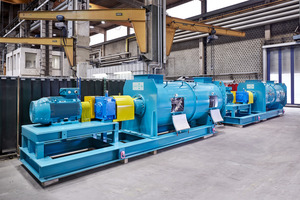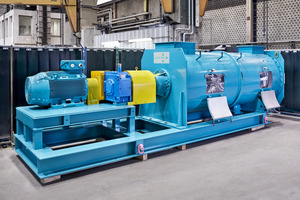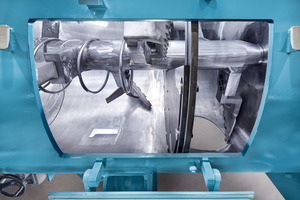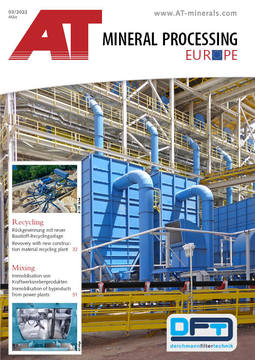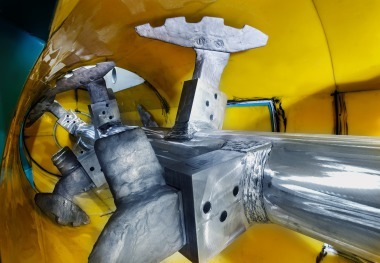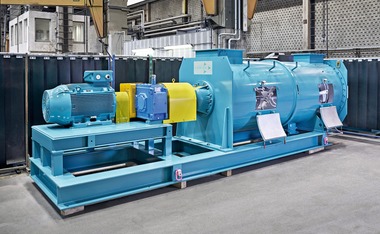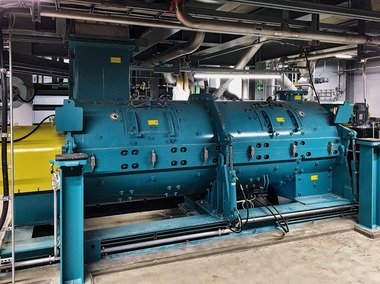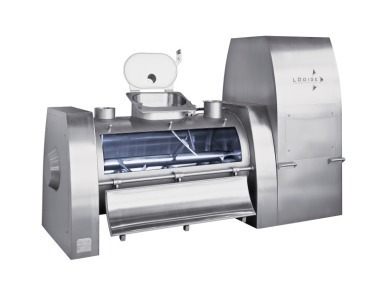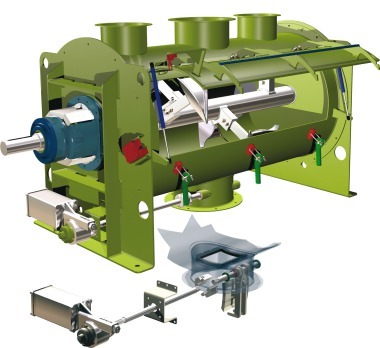Secure immobilisation of byproducts from power plants in Ploughshare® Mixers
Power plants generate more than just power – they also create valuable byproducts. But a homogeneous mixture is necessary to process these securely and beneficially. For many years, Plougshare® Mixers have proven useful for this purpose.
When fossil fuels are burned in power plants, this creates a variety of byproducts, which have been processed and put to further use for decades. Aside from FGD gypsum, these primarily include fly ash and slag. Industrial companies consider these products valuable building materials. They are used by the concrete industry, in earth work and road construction and even in gardening and landscaping. This conserves natural resources and protects the environment.
Production of gypsum
The process for creating a reusable product has undergone repeated optimisation for the past decades. Flue gas desulphurisation systems – FGD for short – are used to remove sulphur compounds from power plants that burn fossil fuels. In the desulphurisation process, the flue gas is sprayed with liquid limewash in an absorption tower. This binds the sulphur dioxide, allowing over 95 % of it to be removed from the flue gas. Then air is supplied to create gypsum through oxidation. This gypsum is of a similar quality to the gypsum created using natural gypsum or anhydrite. This method is used to produce up to 7 million t of FGD gypsum a year in German coal and lignite plants, almost all of which is used by the building industry. For instance, FGD gypsum is highly valued in cement production as setting regulator or for producing sheets of drywall.
For ease of handling, the dehydrated gypsum is usually mixed with fly ash and bed ash generated in the power plant to create a stable, transportable and non-reactive material.
Stabilising fly ash
Fly ash itself is also an important byproduct. Approximately three quarters of the generated black coal fly ash is certified according to DIN EN 450-1 “Fly ash for concrete” or has environmental approval by the building authorities. In particular black coal fly ash has pozzolanic properties that make it of note for the cement and concrete industry as replacement for clinker brick or cement. For instance, fly ash in fresh concrete acts as a liquefier, making the concrete easier to process. At the same time, the fly ash particles fill hollow cavities in the concrete, thus increasing its compressive resistance. The remaining quarter is used in mining, in earth work and road construction, for cement production and for other purposes.
Lignite fly ash, on the other hand, almost exclusively ends up in landfills. The high sulphate and free lime content and the non-homogeneous properties of lignite fly ash prevent it from being used as an additive in cement or concrete. Nevertheless, this type of fly ash also requires stabilisation before secure storage in landfills is possible. Mechanical properties such as water permeability or leachability must be modified.
Immobilisation wanted
Whether gypsum is stabilised, fly ash is processed or stored in landfills: Lödige mixing systems play an essential part in processing all of these power plant byproducts.
For instance, Lödige Ploughshare® Mixers specially designed for this purpose are used to create a homogeneous mixture from FGD gypsum suspensions and fly ash generated by burning coal in order to make use of pozzolanic properties. This application requires an extremely even mixture to achieve sufficient quality.
The primary concerns regarding fly ash generated by burning lignite are the stabilisation and immobilisation of hazardous components. In this case, the recipe must be precisely adjusted to create a solid material suitable for final disposal. Once again the diffusion of gypsum suspension particles in the calcium oxide (CaO) contained in or added to the fly ash forms the basis for the alkaline stabilisation reaction, a process comparable to hardening of cement. The soluble, hazardous components of the initial materials are integrated in newly formed mineral phases. Once these phases only have low solubility, permanent stabilisation - and thus immobilisation - is achieved. The quality of the stabilised product depends on the properties of the fly ash and on the dosing quality of the system, but also on the mixing conditions and mixing quality.
Three-dimensional movement
This is where Ploughshare® Mixers can truly make a difference. They operate based on the mechanically generated fluid bed process, which Lödige introduced to industrial mixing technology. Through intensive forced mixing, they achieve thorough mixing of components and a high mixing quality. The Ploughshare® Mixer is also available for continuous operation. In this application, the mixer stands out thanks to high throughput rates that can be adapted based on the dwell time, filling level and component properties.
To ensure thorough mixing, the Ploughshare® shovels that rotate close to the walls of a horizontal, cylindrical drum have a circumference speed and geometric shape designed to pick up the raw materials for the mixture, overcoming the gravitational force, and radially throw them into the free mixing compartment, while simultaneously moving in an axial direction. The size, number, position, shape and circumferential speed of the shovels are carefully coordinated to create a three-dimensional movement in the materials during the mixing process. The shovel shape generates additional suction to remove particles from the drum wall. This is referred to as the detachment effect.
The mechanically generated fluid bed ensures thorough separation of the particles, in particular in the headspace of the mixer. This optimises availability of the surfaces of individual particles for contact with liquids, a fact that is essential for homogeneous, lump-free mixing and distribution.
The mixing elements are shaped and arranged to ensure secure transport but also sufficient remixing. This generates a “mechanical” fluidised bed, in which the entire product mixture is constantly gripped, resulting in extremely thorough mixing, even with high mixture throughput and short dwell times. The finished mixture is then discharged from the mixer through the discharge opening.
Adapted to the process
Lödige has demonstrated the suitability of its Ploughshare® Mixers for this application by designing numerous successful mixers and systems for stabilisation of power plant byproducts. An application-specific design of the mixing tools and adaptation of the mixing shaft rotation speed permit highly flexible applications of the Lödige Ploughshare® Mixer. For instance, because fly ash is regarded as a highly abrasive material, a heavy-duty mixer design is used for this particular application. It is, incidentally, very common for Lödige to provide not just the mixer but a complete package also including dosing systems, vapour treatment and measuring technology.
Author:
Bastian Tigges
Gebrüder Lödige Maschinenbau GmbH, Paderborn/Germany
www.loedige.de, Tigges@loedige.de
Bastian Tigges is a trained industrial mechanic (specialising in machine and systems technology) and a state-certified mechanical engineer. He has been employed at Gebrüder Lödige Maschinenbau GmbH in Paderborn since 2010. After working in project management for several years, his focus there since 2017 has been on the technical sales of mixing and granulation systems for environmental applications.


